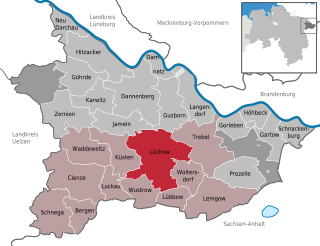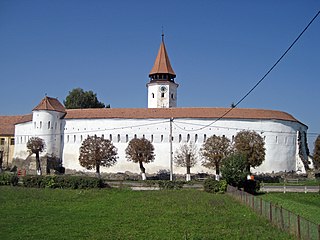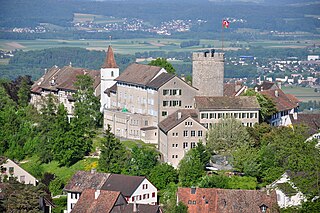

The Stone Tower (German : Steinerne Turm) is a protected monument and historic watchtower in the city of Dortmund, Germany, not far from the Westfalenhallen.


The Stone Tower (German : Steinerne Turm) is a protected monument and historic watchtower in the city of Dortmund, Germany, not far from the Westfalenhallen.
The tower was part of the military defences of the medieval free imperial city of Dortmund and built some distance in front of the city walls of the historic city centre. The watchtower controlled the trade route that ran south from the city to Cologne. It stood on the historical border of Stadthagen, the fortified land around the city that had existed since the 13th century and within which the city rights applied.
Dortmund's Stadthagen was fortified in the 14th century. During the Soest Feud in the mid-15th century the Stone Tower was besieged and damaged by enemy troops, as a consequence of which the lower part was reinforced with thick brick walls. The lower half of the Stone Tower is original, the upper half has been reconstructed.
In addition to this southern watchtower there were another five observation points around the city at comparable distances from it: the Freden Tower (Fredenturm) in the north, the Ederloes Watchtower (Ederloeswarte) in the northeast, the Osterruter Watchtower (Osterruterwarte) in the east, the Bergfrede on the River Emscher and in the west the Westerruter Watchtower ( Westerruterwarte). Later the Hörde Watchtower (Hörder Warte) was built to the south of the Stone Tower on the border between the County of Dortmund and County of Mark on the Emscher.
The Stone Tower is a listed building entered in the monument register of the city of Dortmund. [1]
The Stone Tower is south of the B1, immediately west of the U-Bahn station of Westfalenhallen. This is served by the U45 and U46 lines as well as bus no. 450 of the DSW21.

Dortmund is the third-largest city in North Rhine-Westphalia after Cologne and Düsseldorf, and the eighth-largest city of Germany, with a population of 588,250 inhabitants as of 2021. It is the largest city of the Ruhr, Germany's largest urban area with some 5.1 million inhabitants, as well as the largest city of Westphalia. On the Emscher and Ruhr rivers, it lies in the Rhine-Ruhr Metropolitan Region and is considered the administrative, commercial, and cultural center of the eastern Ruhr. Dortmund is the second-largest city in the Low German dialect area after Hamburg.

Żary is a town in western Poland with 37,502 inhabitants (2019), situated in the Lubusz Voivodeship since 1999. Previously it was located within Zielona Góra Voivodeship (1975–1998). It is the administrative seat of the Gmina Żary, though the town is not part of the gmina commune.

Jülich is a town in the district of Düren, in the federal state of North Rhine-Westphalia, Germany. As a border region between the competing powers in the Lower Rhine and Meuse areas, the town and the Duchy of Jülich played a historic role from the Middle Ages up to the 17th century.

Hörde is a Stadtbezirk and also a Stadtteil (Quarter) in the south of the city of Dortmund, in Germany.

Dülken is a town located in the North Rhine-Westphalia state of Germany. It has a population of about 20,000. It is part of the municipality of Viersen. It received its town charter in 1364 thus being the oldest part of the municipality of Viersen. It lies in the administrative region of Düsseldorf. The river Nette having its source underground in the middle of the town rises near the town. The town motto is, "Gloria tibi Duelken", or "Glory to you, Duelken".

Schmallenberg is a town and a climatic health resort in the High Sauerland District, Germany. By area, it is the third biggest of all cities and towns of the state of North Rhine-Westphalia and the second biggest of the region of Westphalia.

Lüchow (Wendland) is a city in northeastern Lower Saxony, in Germany. It is the seat of the Samtgemeinde Lüchow (Wendland), and is the capital of the district Lüchow-Dannenberg. Situated approximately 13 km north of Salzwedel, Lüchow is located on the German Framework Road. In the Polabian language, Lüchow is called Ljauchüw.

Zons, formerly known as Feste Zons(Fortress Zons), today officially called Stadt Zons is an old town in Germany on the west bank of the Lower Rhine between Cologne and Düsseldorf. It has been a part (Stadtteil) of the town of Dormagen since 1975. In 2010 its population was 5,370.

A fortress church is a particular type of church that, in addition to its religious functions is also used by the local population as a retreat and defensive position, similar to a refuge castle. A fortress church usually implies that the church is enclosed by its own fortifications, such as curtain walls and defensive towers. By comparison, a church with simple defensive features, such as battlements and embrasures on the church itself, is usually just referred to as a fortified church.

Westfalenstadion is a football stadium in Dortmund, North Rhine-Westphalia, Germany, which is the home of Borussia Dortmund. Officially called Signal Iduna Park[zɪɡˌnaːl ʔiˈduːnaː ˌpaʁk] for sponsorship reasons, the name derives from the former Prussian province of Westphalia.

Dortmund-Kurl station is in the Dortmund suburb of Kurl in the German state of North Rhine-Westphalia on the Dortmund–Hamm line. The station has two platform tracks and an overtaking track for long-distance trains and a freight track without platforms, which is no longer used.

The Stone Bridge in Regensburg, Germany, is a 12th-century bridge across the Danube linking the Old Town with Stadtamhof. For more than 800 years, until the 1930s, it was the city's only bridge across the river. It is a masterwork of medieval construction and an emblem of the city.

Altes Stadthaus in Dortmund, North Rhine-Westphalia, Germany, is an office block which was built in 1899, and was designed by "master builder" Friedrich Kullrich. It was built in the Renaissance Revival architecture (Neo-Renaissance) style. After the office block was severely damaged in World War II, it was rebuilt in a simplified form.

St. Peter is a Romanesque church in Syburg, now a suburb of Dortmund, Germany. It is the active Protestant parish church of Syburg, officially named "Ev. Kirche St. Peter zu Dortmund-Syburg". It serves as a concert venue for the bimonthly Syburger Sonntagsmusiken.

Regensberg Castle is a hill castle which was built about the mid-13th century AD by the House of Regensberg in the Swiss municipality of Regensberg in the Canton of Zürich.

The following is a timeline of the history of the city of Dortmund, Germany.

The Bucksturm is a listed historical structure in Osnabrück, Germany.

The terms landwehr, landgraben and landhege refer to border demarcations or border defences and enclosures in Central Europe that were either built by settlements with the right of enclosure or to mark and defend entire territories. These measures, usually comprising earthworks or dykes as well as ditches and impenetrable lines of hedging, for protecting towns and villages date mainly to the High and Late Middle Ages and consist, in some cases, of systems over a hundred kilometres long. Comparable earthworks have been recorded since Antiquity. The Roman limes are the best known examples of earlier landwehrs. The Danewerk is another example of this type of barrier.

The Thick Tower erected in 1250 is part of the historic fortification of Görlitz. The 46m tall tower is the most massive tower in the city. Its walls in the lower part reach a thickness of 5,34m, thus the name of a thick tower. Apart from it, the Nikolai Tower and the Reichenbach Tower are still preserved. In total, Görlitz had four large watchtowers and defense towers.

The Reichenbach Tower probably built in the 13th century and first mentioned in 1376 is the western part of the historic fortification of Görlitz. With a height of 51m it is the tallest of the three fortified towers in Görlitz..
Coordinates: 51°29′48.73″N7°27′32.76″E / 51.4968694°N 7.4591000°E